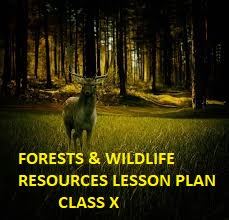Class X Geography Forests & Wildlife Resources Lesson Plan
Forests & Wildlife Resources lesson plan is designed to give students a better understanding of forests and wildlife resources, and how they interact with each other in order to maintain balance in nature. Forests and wildlife are two of the most important natural resources in the world. Exploring natural vegetation is an important part of understanding the diverse and complex ecosystems of the world. Students will learn about the different types of natural vegetation, the importance of protecting wildlife resources, and the effects of deforestation and over-exploitation of resources. By the end of this lesson, students should have a better understanding of the importance of conserving forests and wildlife resources for the benefit of future generations. Click here for the lesson plan of chapter 1 Resources and development.
Class X Geography Forests & Wildlife Resources Lesson Plan
Objective:
To understand the importance of Forests & Wildlife Resources.
General Objective:
- To create interest in the subject.
- To create awareness about the importance of Forests & Wildlife resources.
Specific Objective:
- To introduce students to the concepts of forests and wildlife resources.
- understand the importance of forests and wildlife in maintaining the ecological balance of our environment.
- identify the various threats that forests and wildlife face in the modern world.
- to identify possible solutions for protecting and preserving forests and wildlife.
- explain the role of community in conservation of forests and wildlife.
- to develop strategies for promoting responsible use of natural resources.
- to provide a safe and healthy environment for both humans and animals.
- explore innovative ways to engage students in projects that help protect and preserve forests and wildlife.
- to encourage students to become active participants in conservation efforts for their local community.
Teaching Aid: (Forests & Wildlife Resources Lesson Plan)
In order to effectively teach the lesson on forests and wildlife resources, teachers should make use of various teaching aids. Visuals are a great way to get students engaged in the subject matter, so
Posters and diagrams:
It can be used to illustrate concepts such as the food web, habitat destruction, and animal endangerment.
Maps of local and global forests
This will help students contextualize their learning.
Storybooks about forests and wildlife:
Will help engage them and bring the topic to life.
Documentaries about forests and wildlife:
can also be used to supplement the lesson plan, offering students a different perspective on the issues.
Relevant educational websites:
Relevant educational websites and online games can be used to further enhance student learning.
Class X Geography Forests & Wildlife Resources Lesson Plan
Teaching methodology
When teaching about forests and wildlife resources, it is important to choose activities and approaches that engage students in meaningful and active learning. This can be done by encouraging students to explore their local ecosystems, as well as by incorporating technology such as virtual field trips, podcasts, and videos. It is also important to provide opportunities for discussion and collaboration between students so that they can develop an understanding of how humans interact with and impact the environment.
Inquiry-based activities
The teacher will use inquiry based activities to allow students to explore and investigate the various components of the natural environment. For example, ask students to collect data on a local species of plant or animal in their area, observe and report on changes in the environment, or conduct experiments on water quality. These activities allow students to become immersed in the subject matter and gain a deeper understanding of forests and wildlife resources.
Discussing current events
The teacher will also use this method related to forests and wildlife conservation efforts. This allows students to see how environmental science applies in the real world and can help them connect their learning to issues happening in the community or around the globe.
Finally, it is important to create assignments that challenge students to think critically about the role of humans in caring for our environment. Consider having students design an action plan for conserving an endangered species or creating a community garden. By engaging students in these activities, you can help them make connections between their learning and their potential to make a difference in the preservation of forests and wildlife resources.
Discussing the importance of forests and wildlife
Forests and wildlife are an essential part of our environment and they play a vital role in sustaining life on earth. They provide us with food, water, fuel, shelter, and medicines. Forests also help to regulate climate, control soil erosion, and support biodiversity. In addition, they act as carbon sinks, storing carbon and helping to mitigate global warming.
Forests and wildlife provide livelihoods for millions of people around the world. They are a source of income and employment for local communities, providing food, medicine, fuel, and building materials. Forests also play a vital role in providing spiritual, cultural, and recreational opportunities for people.
Role of Community In Conservation of Forests and Wildlife
Conservation of forests and wildlife is not only the responsibility of governments, but it is also the responsibility of local communities. Local communities play a key role in conservation efforts as they are often the closest to the affected areas and can help promote conservation and protection of forests and wildlife resources.
Local communities can contribute in many ways, such as by participating in awareness campaigns, by engaging in sustainable practices, such as agroforestry, or by supporting local conservation efforts. Communities can also help protect forests and wildlife resources by engaging in community-based management approaches that involve both local people and stakeholders. Through community-based approaches, locals can have a say in decision making processes and be able to collaborate with others in efforts to conserve forests and wildlife.
Local communities can also serve as advocates for conservation efforts, by voicing their concerns about threats to forests and wildlife and encouraging authorities to take action. In addition, communities can support research into issues that affect forests and wildlife, such as climate change, land use change or illegal logging.
Finally, local communities can serve as ambassadors for the conservation of forests and wildlife, by promoting education and awareness amongst their peers, families and friends. By raising awareness of the importance of forests and wildlife, locals can help ensure that the environment is preserved for future generations.
Class X Geography Forests & Wildlife Resources Lesson Plan
Activities Planned
Forest Exploration:
The first activity we plan to do with our students is a forest exploration. We will take the students on a guided tour of the local forest, teaching them about the different plants and animals that live there. We will discuss the importance of forests for wildlife habitats, as well as the various threats facing them. Students will also learn about how people can help conserve forests and wildlife.
Indoor Game:
The second activity we plan to do is to set up a game or simulation where students must decide how to balance economic development with the protection of forests and wildlife. This will give students an opportunity to use critical thinking skills while developing an understanding of the complex decisions that need to be made in order to protect our environment. They will also gain a better understanding of the importance of conservation efforts.
Art Integration:
Design a 5000 rupees currency note with a picture of our National animal or Bird and mention the steps taken by the government to protect it.
Classwork
- The teacher will provide class notes related to the topic.
- Short and long answer type questions will be discussed and done.
Homework
- Read about the role of Bishnoi Community in the conservation of Forests and wildlife.
- Also read about Chipko Movement and Joint Forest Management.
- Mark National parks and Bioreserves in the Political Map of India.
What you can do?
Protecting forests and wildlife resources is everyone’s responsibility. Here are some of the things you can do to help conserve these important ecosystems:
- Participate in local conservation activities such as tree-planting events, beach clean-ups, or volunteer with an environmental organization.
- Become an advocate for environmental protection by writing letters to local politicians or signing petitions.
- Be mindful of your consumption and avoid products that involve animal cruelty or habitat destruction.
- Get involved in sustainable farming practices such as composting and rainwater harvesting.
- Educate yourself and others on the importance of preserving natural habitats and the biodiversity they support.
- Support conservation organizations that are actively protecting forests and wildlife.
- Choose sustainable seafood, such as fish caught using pole-and-line methods or those that are certified by the Marine Stewardship Council (MSC).
By taking action and spreading awareness, we can all play a part in protecting our forests and wildlife resources.
Learning Outcome
The learning outcome for this lesson plan on forests and wildlife resources is for students to gain an
- Firstly, understanding of the importance of forests and wildlife resources and the current threats they face.
- Secondly, will learn about the role of their community in protecting and conserving these resources, as well as two classroom activities designed to explore these concepts.
- Finally, through this lesson plan, students should develop an appreciation of the environmental and ecological importance of forests and wildlife resources and understand what can be done to help protect them. By the end of the lesson, students should understand that they have a personal responsibility to protect and conserve these precious resources.
Conclusion On Forests & Wildlife Resources:
Forests and wildlife are two of the most important natural resources in the world. They provide us with oxygen, water, food, and materials for building, among other things. The types of forests and wildlife vary from place to place and region to region, each playing a vital role in the local ecosystem. Conservation of these resources is key to protecting biodiversity, supporting sustainable development, and preserving the many benefits these resources provide. It is also important to recognize the role that the community has in managing and protecting forests and wildlife resources.





0 Comments